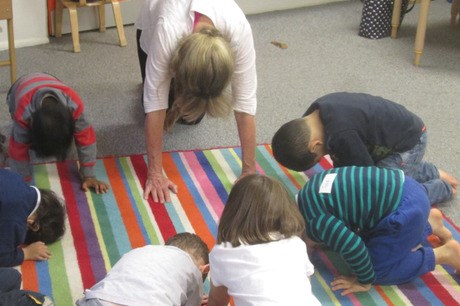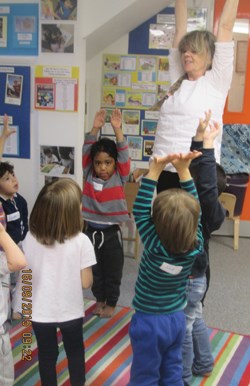Enabling Environments: Yoga - At a stretch
Caroline Vollans
Monday, December 14, 2015
Although some yoga exercises can be inappropriate for the under-16s, a programme tailored for young children has many benefits. Caroline Vollans finds best practice in action at a London setting

The mention of yoga for babies and young children often evokes an enthusiastic response along with positive comments on the wealth of benefits it has to offer. Yoga, a practice dating back over 5,000 years and growing in popularity around the world, is a discipline of mental and physical activity known for its multi-faceted contribution to general well-being. It is a practice that has become widespread in family and early years settings. Not all professionals in the field, however, are so keen, with reactions ranging from the sceptical to the horrified.
The fears about yoga for babies and young children were highlighted when Lena Fokina, a Russian yoga instructor, posted a YouTube clip in 2011 (later removed) of her holding very young children by their limbs and vigorously swinging them around. While Fokina maintains that her practice is beneficial, many disagree vehemently and regard it as dangerous. Indeed, it is not only the extremes of yoga as performed by Fokina that provide cause for concern, but there are a range of potentially harmful side-effects involved in the practice. What, then, are the major risks associated with pre-school children doing yoga?
Yoga exercises can be inappropriate for the under-16s because their nervous and glandular systems have not finished growing and the effect of such exercises could interfere with development. Many stretches target the nerves in the legs, arms, neck and spine; if poses are held for too long, they can put too much strain and pressure on young children’s bodies. Children under three might not know when they are over-stretching and when to stop, and young children might be unable to pinpoint pain.
Certain breathing techniques might be contraindicated if a child has asthma, bronchitis or a hernia. Yoga may be used instead of all-important cardiovascular activities, meaning that children are not getting the range of exercise they need. Finally, certain poses or movements may cause small children or infants to vomit if they have recently eaten.

Yoga teacher Janet Walter goes through some poses at Dorothy Gardner Nursery School and Children’s Centre
WITH CONFIDENCE
Dorothy Gardner, a long-established nursery school and children’s centre for two- to four-year-olds in North West London, provides yoga as part of its curriculum enrichment programme. It is confident that children are not exposed to any of the risks outlined above.
Dorothy Gardner welcomes Janet Walter every Wednesday morning to lead two sessions of yoga. Janet, a former Montessori teacher and fully trained, experienced yoga teacher, started working in the borough over ten years ago and now works in several early years and family settings. ‘Word got around,’ says Janet. ‘I started in a family centre with mothers and toddlers – they liked what I did and recognised the benefits it had.’
The first benefit, as far as Janet is concerned, is that the children love it. In her many years of practice, she has never had a child not wanting to take part: the children are keen to return to their weekly sessions. Why does she think this is the case?
An important element of each session is that it has a very particular structure and rhythm. The children get to know this and the feeling of familiarity is an important part of the process. It is a clearly bordered space for them and this lends itself to a feeling of safety and being held. For those children from chaotic and inchoate families, this is an especially significant quality.
Rachel Chapman, from the senior leadership team at Dorothy Gardner, says she would ideally like all children to participate. There are no specific selection criteria, but those children with particular physical, sensory and emotional needs tend to take priority. Two sessions with a maximum of ten children for the duration of a term is the capacity at the moment.
‘The children have a very unique experience in yoga: those children who seem not to be able to sit still and sustain an activity for very long are able to do so during yoga – it’s amazing,’ says Rachel. ‘It’s tempting for us to think that children only need lots of the more obviously energetic exercise to channel their energies and release pent-up emotion, but they seem to really appreciate the stillness and the silences.’
Rachel has witnessed children able to find and occupy a very different bodily and emotional state when engaged with yoga. She continues, ‘Yoga offers something new and beyond what we can offer on a daily basis – we have really learnt from it.’
GENTLE POSTURES
 Yoga at Dorothy Gardner is held in the library where there is a thick, non-slippy carpet and Janet has calming music playing as the children enter. They take off their shoes and socks and sit down with their legs crossed. The session begins with the children massaging (rubbing) their chests while saying their names.
Yoga at Dorothy Gardner is held in the library where there is a thick, non-slippy carpet and Janet has calming music playing as the children enter. They take off their shoes and socks and sit down with their legs crossed. The session begins with the children massaging (rubbing) their chests while saying their names.
As it progresses, they go in and out of various gentle postures using an array of breathing techniques. This is a particularly rhythmical aspect of the session where various animal breaths such as a lion’s, a buzzy bee’s, a lion’s and so on are used to encourage different tempos of breathing and provide the opportunity for a range of outlets and releases.
Postures, often with animal names, are repeated from week to week with new ones being introduced gradually over time. The session lasts for 30 minutes, and the final five minutes, in Janet’s experience, is the favourite component for many children. The lights are dimmed, the children lie on their backs and a small lavender bag is placed over their eyes while a little lavender oil is massaged into their foreheads.
The children listen to the music, smell the lavender and Janet asks them to think of something that makes them happy. Janet repeats their names and the session concludes with the children rocking and sitting with their legs crossed, the posture that starts and ends the sessions, and saying ‘namaste’, a traditional greeting of respect and thanks.
This version of yoga does not involve any strenuous manipulations, inverted positions, forcing or over-stretching. The intention is not for the child to be stretched and moved but for them to stretch and move in a way that is suitable for them. It is all done so that each individual child moves, breathes and stretches moderately and at their own pace – this is key to Janet’s practice.
ONE-TO-ONE SUPPORT
Children who receive one-to-one support are accompanied by their adult so that they can be helped and monitored throughout. Touch is used for a gentle massage or stroke and if the children need a little help with the postures, but this is not with any strength at all, more of a guidance or direction. Janet is insistent that she would not work with imposed force and manipulation. This, for Janet, is not what yoga per se is about – ‘it is both dangerous and not at all the point.’ She continues, ‘Yoga is often seen as trying to resume postures that were natural to us as young children, so children are naturals.’
‘Yoga is often seen as trying to resume postures that were natural to us as young children, so children are naturals’
For Janet, the challenges particular to working with such young children are, first, keeping them interested and focused. She thinks this is facilitated through the use of her voice, her encouragement, the repetition of the various poses, music that they get to know and like, the words and also the silences.
Janet comments on the contribution yoga can make to the children’s concentration, listening, gross motor skills, sense of rhythm and confidence. It can also offer them an initial introduction to the art of meditation or mindfulness – the sense of being still in the moment and having some control of their ability to be and to feel.
As with all early years practice, yoga with young children must be carried out with a lot of thought, consideration and great care. It is essential to employ a fully trained professional who engages constantly with the staff team and who reviews practice with them, including any concerns, however minor.
The carefully managed yoga programme at Dorothy Gardner has enhanced the well-being and physical development of the range of children who take part, as well as giving them an enjoyable experience that they look forward to.




